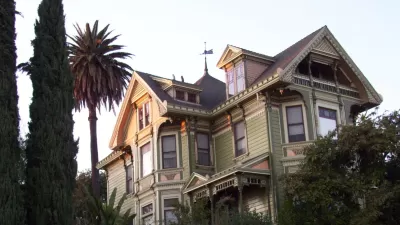Single-story, tiled-roof houses called hanok used to cover the footprint of Seoul, now a city of skyscrapers and avant-garde architecture. Today many describe the hanok as "endangered,"and conflict has come to a head in the small district of Bukchon.
The hillside district of Bukchon in central Seoul is the perfect microcosm for a larger conflict between traditional and modern cultural values that is presently escalating in South Korea. This is where some of the last traditional residential dwellings, called hanoks, stand clustered in noteworthy numbers. Hanoks are particularly admired by historical preservationists for their handcrafted construction and unique design elements such as interior private courtyards. The conflict parallels a larger debate over whether South Koreans are blatantly eschewing their cultural heritage in favor of the new and technologically-advanced.
According to Mark McDonald of The New York Times:
"For all its outward calm and quietly elegant architecture, Bukchon is also a place of anger and suspicion. The preservationists, you see, are at each other's throats."
" 'They want to kill my husband and drive us out,' said one resident, Jade Kilburn, a Korean entrepreneur, who, alongside her British husband, David, has battled their neighbors, the police, the courts and a range of city technocrats in an effort to protect Bukchon's traditional houses from being tarted up or demolished outright."
"Not so long ago, Bukchon had 2,500 hanok. Now there are barely 800, and only one street in the whole neighborhood remains untouched. Preservationists believe the original hanok are now as endangered as any whale or panda. Bukchon, for them, is the last rain forest in a city of chainsaws."
FULL STORY: Saving a Korean District

Alabama: Trump Terminates Settlements for Black Communities Harmed By Raw Sewage
Trump deemed the landmark civil rights agreement “illegal DEI and environmental justice policy.”

Study: Maui’s Plan to Convert Vacation Rentals to Long-Term Housing Could Cause Nearly $1 Billion Economic Loss
The plan would reduce visitor accommodation by 25% resulting in 1,900 jobs lost.

Planetizen Federal Action Tracker
A weekly monitor of how Trump’s orders and actions are impacting planners and planning in America.

Wind Energy on the Rise Despite Federal Policy Reversal
The Trump administration is revoking federal support for renewable energy, but demand for new projects continues unabated.

Passengers Flock to Caltrain After Electrification
The new electric trains are running faster and more reliably, leading to strong ridership growth on the Bay Area rail system.

Texas Churches Rally Behind ‘Yes in God’s Back Yard’ Legislation
Religious leaders want the state to reduce zoning regulations to streamline leasing church-owned land to housing developers.
Urban Design for Planners 1: Software Tools
This six-course series explores essential urban design concepts using open source software and equips planners with the tools they need to participate fully in the urban design process.
Planning for Universal Design
Learn the tools for implementing Universal Design in planning regulations.
Caltrans
Smith Gee Studio
Institute for Housing and Urban Development Studies (IHS)
City of Grandview
Harvard GSD Executive Education
Toledo-Lucas County Plan Commissions
Salt Lake City
NYU Wagner Graduate School of Public Service





























